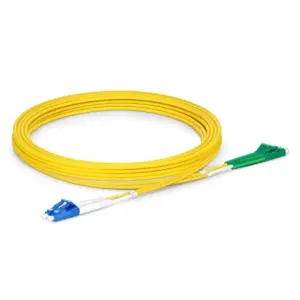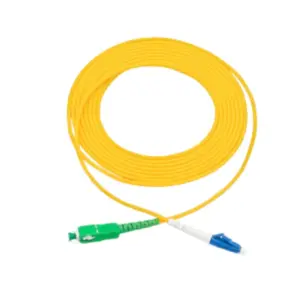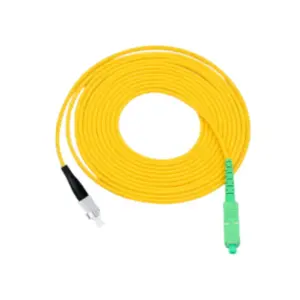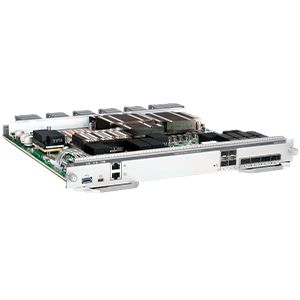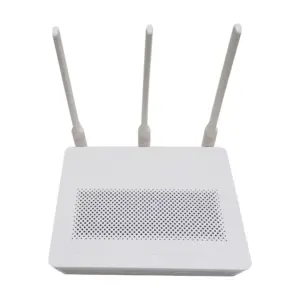Welcome to read this article. We will introduce you to the basic concepts and functions of APC fiber optic patch cords and their important applications in fiber optic communication networks and data centers. We will delve into the characteristics and design principles of APC connectors so that you can better understand the advantages of this technology.
APC optical fiber jumpers have a wide range of application scenarios in optical fiber communication networks and bring many advantages. We will focus on its lower reflection loss (RL) characteristics and the impact of insertion loss (IL) on optical signal transmission. In addition, we will provide precautions for the installation, connection, cleaning and maintenance of APC fiber optic patch cords to ensure you can properly use and maintain this critical equipment.
After understanding the characteristics and usage precautions of APC optical fiber jumpers, we will introduce the relevant international standards and specifications, as well as the methods and requirements for connection reliability testing. These standards and test methods will help you ensure the quality and reliability of fiber optic patch cords.
Finally, we will look at the future development trends of APC fiber optic patch cords, including their application prospects in high-density fiber optic connections and all-optical networks. As technology continues to advance, APC fiber optic patch cords will continue to play an important role in meeting the growing demand for fiber optic communications.
Introduction to APC fiber optic patch cord
Definition and functions:
APC fiber optic patch cord is a fiber optic patch cord that uses APC (Angled Physical Contact) connectors. It is used to connect fiber optic equipment in fiber optic communication systems, such as fiber optic transceivers, fiber optic switches, etc. APC fiber optic patch cords are mainly used in applications requiring high reflection loss and low insertion loss, such as fiber optic transmission, fiber optic sensing and measurement.
APC connector:
The APC connector is a specially designed fiber optic connector that is different from the common UPC (Ultra Physical Contact) connector. It achieves low reflection loss and high reflection suppression through the design of the oblique contact surface.
Features and design principles:
-
Beveled contact surface: The contact surface of the APC connector is tilted at a small angle (usually 8 degrees) to reflect light away from the contact surface and reduce the energy reflected back to the fiber. This bevel design can effectively reduce reflection loss and reduce echo interference in fiber connections.
-
High angle accuracy requirements: The manufacturing of APC connectors requires precise control of the angle and quality of the contact surface. This requires the use of high-precision processes and equipment during the manufacturing process to ensure that the bevel accuracy of the contact surface meets the requirements.
-
Green shell: In order to easily distinguish APC connectors from other types of connectors, green shells are usually used as logos. This helps users correctly select and insert APC connectors during fiber optic connections.
-
High reflection suppression: Due to the design of the oblique contact surface, the APC connector can effectively suppress the echo of reflected light during the connection process. This is critical to the performance and stability of fiber optic systems, especially in high-speed data transmission and long-distance transmission.
APC fiber optic jumpers use specially designed APC connectors to achieve low reflection loss and high reflection suppression through angled contact surfaces. It is widely used in optical fiber communication systems that require high performance and high reliability, providing stable, low-loss optical fiber connections.
Application fields of APC fiber optic patch cord
Optical fiber communication network:
In optical fiber communication networks, APC optical fiber jumpers are widely used in scenarios requiring high performance and low loss. The following are the application scenarios and advantages of APC optical fiber jumpers in optical fiber communication networks:
-
Long-distance transmission: Due to the special design of the APC connector, it can effectively suppress reflection loss and provide high reflection suppression capability. This makes APC fiber optic patch cords very suitable for long-distance transmission, reducing signal attenuation and echo interference, and improving the reliability and performance of fiber optic networks.
-
High-speed data transmission: In high-speed optical fiber communication systems, signal transmission quality is crucial to system performance. The low reflection loss and high reflection suppression capability of APC fiber optic patch cords can reduce signal distortion and attenuation and improve signal quality and reliability. This makes APC fiber optic patch cords an ideal choice in high-speed fiber optic communication systems.
-
Optical fiber connector connection: Equipment in the optical fiber communication network usually needs to be connected using optical fiber jumpers. APC optical fiber jumpers use APC connectors to provide stable, low-loss optical fiber connections. It can ensure the effective transmission of optical signals, reduce loss and interference in connections, and improve the reliability and performance of the network.
data center:
In the data center environment, APC fiber optic patch cords also have important applications and impacts. The following are the uses of APC fiber optic patch cords in data centers and their impact on signal quality:
-
High-density connections: Data centers usually require a large number of fiber optic connections and the connection density is very high. APC optical fiber jumpers use small-sized connectors and high-density optical fiber cabling to meet the high-density connection needs of data centers and provide compact and reliable connection solutions.
-
Signal quality assurance: In data centers, high-speed data transmission and low latency are very critical. APC optical fiber jumpers provide stable signal transmission by reducing reflection loss and echo interference, ensuring the signal quality and reliability of the data center network. This is critical for high-performance computing and large-scale data transfer in data centers.
-
Fiber optic equipment connections: Servers, storage devices, and network devices in data centers are often interconnected using fiber optic connections. APC fiber optic patch cords provide high-quality fiber optic connections, ensuring stable communication and data transmission between devices. It reduces loss and interference in connections, improving the reliability and performance of data center networks.
APC fiber optic patch cords are widely used in fiber optic communication networks and data centers. It is suitable for scenarios such as long-distance transmission, high-speed data transmission and high-density connections, and provides low loss, high reflection suppression and stable optical fiber connections. The application of APC fiber optic patch cords can improve signal quality, improve system performance, and meet the high performance and reliability requirements of fiber optic communication networks and data centers.
Features and advantages of APC fiber optic patch cord
Reflection loss (RL):
APC optical fiber jumpers have lower reflection loss than PC (Physical Contact) connectors. This is due to the angled contact surface design of the APC connector. In contrast, the contact surfaces of PC connectors are flat and have no bevel design.
The oblique contact surface causes the optical signal emitted from the APC connector to be obliquely reflected at the contact surface between the connector and the optical fiber. This oblique reflection can guide the reflected light to the outside of the fiber, reducing the chance of reflected light entering the fiber. As a result, APC fiber optic patch cords achieve lower reflection losses.
By reducing reflection losses, APC fiber optic patch cords can provide more stable optical signal transmission and higher system performance. Especially in applications that need to avoid reflection interference and improve signal quality, such as long-distance transmission, high-speed data transmission and optical fiber sensing, APC fiber optic patch cords have obvious advantages.
Insertion loss (IL):
Insertion loss refers to the optical power loss that occurs when an optical signal passes through a connector. The insertion loss of APC fiber optic jumpers is related to the design and quality of the connector.
The insertion loss of APC fiber optic patch cords is usually slightly higher than that of PC fiber optic patch cords. This is due to the angled contact surface design of the APC connector that introduces additional optical signal transmission loss. However, this increase in insertion loss is acceptable and will not have a significant impact on the transmission of optical signals in most applications.
It is important to note that the insertion loss levels of APC fiber optic patch cords are still within specifications for fiber optic communications systems and will not severely impact system performance. At the same time, APC fiber optic patch cords improve the reliability and stability of the system through low reflection loss, which is more important in many applications.
APC fiber optic patch cords have lower reflection loss and slightly higher insertion loss than PC connectors. Through the angled contact surface design, APC connectors can achieve lower reflection loss, provide more stable optical signal transmission and higher system performance. Although the insertion loss is slightly higher, it is still within the acceptable range and will not have a serious impact on most fiber optic communication systems. Overall, APC fiber optic patch cord has obvious advantages in providing low reflection loss and stable signal transmission.
Precautions for using APC fiber optic patch cord
Installation and connection:
When installing and connecting APC fiber optic patch cords, here are some recommendations and steps to ensure proper connections and optimal signal transmission:
-
Make sure the fiber optic connector is clean: Before connecting, be sure to check whether the end face of the connector is clean. Using an appropriate cleaning tool, such as a fiber optic cleaning wand or wipes, gently clean the connector end faces to ensure there is no dust, dirt, or fingerprints.
-
Handle connectors with care: Be careful when handling connectors to avoid touching the end faces of the connectors. Fingerprints or dirt may affect the transmission quality of optical signals.
-
Align the connectors: Align the connector of the APC fiber patch cord with the connector of the device or another optical fiber. Make sure the connector’s angled contact surfaces mate correctly with the other connectors. Do not force insertion or apply excessive pressure to avoid damaging the connector.
-
Gently insert the connector: Using appropriate insertion force, gently insert the connector of the APC fiber patch cord into the device or the connector of another optical fiber. Make sure the connector is inserted into place and that the connection is secure.
-
Avoid bending and tension: When laying out and installing APC fiber optic patch cords, avoid excessive bending or applying excessive tension. Excessive bending and tension may cause fiber damage or loose connectors, affecting signal transmission quality.
Cleaning and Maintenance:
In order to maintain the signal transmission reliability of APC fiber optic patch cords, here are some cleaning and maintenance points:
-
Clean the connector regularly: Check and clean the connector end face of the APC fiber optic patch cord regularly. Use a dedicated fiber optic cleaning tool and follow the cleaning tool’s instructions to remove dirt and fingerprints.
-
Avoid exposure to dust and contaminants: Keep APC fiber optic patch cords away from dust and contaminants. Try to avoid exposing the connector to the air and use protective caps or sleeves to protect the connector end faces.
-
Avoid excessive bending and pulling: During use, avoid applying excessive bending or pulling force to the fiber jumper. Excessive bending and tension can cause fiber damage or loose connectors.
-
Regularly check the connection status: Regularly check the connection status of the APC fiber jumper to ensure that the connector is stable and not loose. Re-plug or replace the connector if necessary.
Please note that specific installation, connection, cleaning and maintenance steps may vary based on actual conditions and equipment requirements. Before performing any operation, refer to the equipment and manufacturer’s guidelines and follow appropriate operating instructions.
Standards and specifications for APC fiber optic patch cords
International standards:
The main international standards and specifications related to APC fiber optic patch cords include:
-
IEC 61753 series: This is a series of standards issued by the International Electrotechnical Commission (IEC), covering requirements and test methods for optical fiber connectors, connector insertion loss and reflection loss.
-
TIA-604 (FOCIS) series: This is a series of standards issued by the Telecommunications Industry Association (TIA), covering the requirements and specifications for fiber optic connectors and fiber optic patch cords.
-
ISO/IEC 11801: This is a standard jointly issued by the International Organization for Standardization (ISO) and IEC. It is used to standardize the structural wiring of communication systems, including the requirements and specifications for fiber optic jumpers.
-
GR-326-CORE: This is a standard issued by the Telecommunications Engineering Branch (Telcordia) of the United States to standardize the requirements and performance of fiber optic connectors.
These international standards and specifications provide manufacturers, suppliers and users with a benchmark for consistency and interoperability, ensuring that the quality and performance of APC fiber optic patch cords meet industry requirements.
Connection reliability test:
For connection reliability testing of APC fiber optic patch cords, the following are some common methods and requirements:
-
Reflection loss test: Measure the reflection loss (RL) of the connector by using optical fiber test instruments, such as optical power meters and light sources. This test evaluates the connector’s reflective properties to ensure it meets specification requirements.
-
Insertion loss test: Use fiber optic testing equipment to measure the insertion loss (IL) of the connector. Insertion loss testing measures a connector’s transmission loss of optical signals to ensure it is within specified limits.
-
Tension test: Test the connection strength between the connector and the optical fiber by applying appropriate tension. Pull testing ensures the connector will not loosen or fall off during normal use.
-
Vibration and impact testing: Test the connector’s anti-vibration and impact resistance by simulating vibration and impact environments. These tests evaluate the connector’s reliability under harsh conditions.
-
Environmental adaptability test: Test the performance of the connector under different environmental conditions, such as temperature changes, humidity, corrosion, etc. These tests ensure that the connector adapts to various working environments and maintains stable performance.
The specific methods and requirements for these connection reliability tests may vary depending on standards, specifications, and application needs. It is recommended to refer to applicable standards and specifications and use appropriate test equipment and methods when conducting connection reliability testing.
The future development trend of APC fiber optic patch cord
High-density connections:
In high-density fiber optic connections, APC fiber optic patch cords have broad application prospects. Here are some relevant trends:
-
MPO/MTP connection: MPO (Multimode Parallel Optical) or MTP (Multimode Transmission System) connector is a common connector type used for high-density fiber optic connections. APC fiber optic patch cords can be used in conjunction with MPO/MTP connectors to achieve high-density fiber optic connections.
-
High-end data centers: As data centers continue to develop and expand, the demand for high-capacity, high-speed, and high-density optical fiber connections is also increasing. As a reliable connection solution, APC fiber optic patch cord will be widely used in high-end data centers.
-
Fiber optic switches and routers: As network equipment continues to be upgraded and network capacity increases, the demand for high-density fiber optic connections is also growing. APC fiber optic patch cords can meet the requirements of high-density connections and provide excellent signal transmission performance.
All-optical network:
The all-optical network is a network architecture based on optical fiber transmission, which has the characteristics of high bandwidth, low latency and large capacity. In all-optical networks, APC optical fiber jumpers will develop as follows:
-
Low insertion loss and high reflection loss: All-optical networks have higher performance requirements for connectors and require connectors with low insertion loss and high reflection loss. The angled contact surface design of APC fiber optic patch cord makes it has low insertion loss and excellent reflection loss performance, and is suitable for the requirements of all-optical networks.
-
High-rate transmission: As the data transmission rate in all-optical networks continues to increase, APC fiber optic patch cords will adapt to higher transmission rate requirements. It can support high-rate optical signal transmission, such as 10G, 40G, 100G or even higher rates.
-
Anti-interference ability: In all-optical networks, fiber jumpers need to have good anti-interference ability to ensure the stability and reliability of signal transmission. The angled contact surface design of APC fiber optic jumpers can reduce the reflection and interference of optical signals and provide more stable signal transmission.
In summary, with the development of high-density connections and all-optical networks, APC fiber optic patch cords will continue to develop and be used in a wider range of fields. It will meet the growing demand for fiber optic connections and provide higher performance signal transmission solutions.
Summarize:
By reading this article, you will have a deeper understanding of the definition, functions and characteristics of APC fiber optic patch cords. As an indispensable component in fiber optic communication networks and data centers, APC fiber optic patch cords provide you with stable and reliable fiber optic connections through their lower reflection loss and optimization of optical signal transmission.
Following correct installation, connection, cleaning and maintenance methods, as well as complying with international standards and conducting connection reliability testing, will ensure that you take full advantage of the advantages of APC fiber optic patch cords and contribute to the successful operation of fiber optic communications.
Looking to the future, with the rapid development of high-density fiber optic connections and all-optical networks, APC fiber optic patch cords will continue to evolve and innovate to meet the growing demand. We look forward to making progress with you during this development process and making positive contributions to the future development of the optical fiber communications field.


